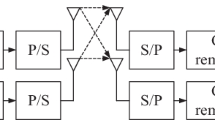Abstract
Cooperative communication is one of the major diversity techniques which exploit spatial diversity through a virtual antenna array. In addition to cooperation, transmitting the same symbols through different sub carriers (Multi-Carriers) introduces frequency diversity as well. The objective of this paper is to investigate cooperative diversity performance in Multi-Carrier Code Division Multiple Access (MC-CDMA) systems with orthogonal and non-orthogonal spreading codes. We evaluate the Symbol Error Rate (SER) of cooperative transmission in frequency-selective Rayleigh faded uplink channel. We focus on the use of despreading-combining (DC) receiver and coherent detection with Maximal Ratio Combining for the above selected criteria respectively. It is shown that the orthogonal spreading code cancels Multiple-Access Interference (MAI) and the performance is completely independent of the length of the spreading code. The approximate SER derived here for the the transmission scheme is well matched with the increasing number of users in the system. Hence the Gaussian approximation is acceptable for systems which are operating with their maximum user capacities at lower SNR values.
Similar content being viewed by others
References
Nosratinia A., Hunter T. E. (2004) Cooperative communication in wireless networks. Communications Magazine IEEE 42(10): 74–80
Laneman J. N., Tse D., Wornell G. W. (2004) Cooperative diversity in wireless networks: Efficient protocols and outage behavior. IEEE Transactions on Communications 50(12): 3062–3080
Hunter, T. E., & Nosratinia, A. Cooperation diversity through coding. In Proceedings of IEEE international symposium on information Theory. Lausanne, Switzerland.
Janani M., Hedayat A., Hunter T. E., Nosratinia A. (2004) Coded cooperation in wireless communications: Space-time transmission and iterative decoding. IEEE Transactions on Signal Processing 52(2): 362–371
Xianjing, Z., Baoyuj, Z., Chen, N., Laneman, C., & Cui, J. (2006). The BER performance analysis of a cooperative diversity scheme. Communications, circuits and systems proceedings, 2006 international conference on, Vol. 2, (pp. 870–874).
Nabar R. U., Bolcskei H., Kneubühler F. W. (2004) Fading relay channels: Performance limits and space-time signal design. IEEE Journal on Communications 22(6): 1099–1109
Helmut B., Borgmann M., Paulraj A. J. (2003) Impact of the propagation environment on the performance of space-frequency coded MIMO-OFDM. IEEE Journal on Communications 21(3): 427–439
Hara S., Prasad R. (1999) Design and performance of multicarrier CDMA system in frequency selective rayleigh fading channels. IEEE Transaction on Vehicular Technology 48(5): 1584–1594
Stuber G. L. (1958) Principles of mobile communication, 2nd ed. Kluwer Academic Publishers, London
Miller S. L., Rainbolt B. J. (2000) MMSE detection of multicarrier CDMA. IEEE Journal on Selected Areas in Communications 18(11): 2356–2362
Je-hong, J., & Kim, S. G. (2002). Performance of multicarrier CDMA systems using maximal-ratio combining MMSE detection. Vehicular technology conference, 2002. VTC Spring 2002. IEEE 55th, Vol. 3, (pp. 1546–1549) May. 2002.
Shi Q., Latva-aho M. (2002) Exact bit error rate calculations for synchronous MC-CDMA Over a Rayleigh fading channel. IEEE Communication Letter 6: 276–278
Verdu S. (1958) Multiuser detection, 3rd ed. Cambridge University Press, New York
Gui X., Tung S. N. (1999) Performance of asynchronous orthogonal multicarrier CDMA system in frequency selective fading channel. IEEE Transaction on Communicatios 47(7): 1084–1091
Zhao, X., Zheng, B., Chen, C., & Cui, J. (2006). The BER performance analysis of a cooperative diversity scheme. Communications, circuits and systems proceedings, 2006 international conference, Vol. 2 (25–28), (pp. 870–874). July. 2006.
Cao, Y., & Vojcic, B. (2004). MMSE multiuser detection for cooperative diversity CDMA systems. Wireless communications and networking conference, 2004. WCNC. 2004 IEEE, Vol. 1, (pp. 42–47). March 2004
Hujun, Y., & Hui, L. (1998). Trnasmitter-receiver design in multicarrier CDMA communication. Thirty second asilomar conference on signals systems & computers, Vol. 1, (pp. 154–158). March 1998.
Simon M. K., Alouini M.-S. (2005) Digital communication over fading channels, 2nd ed. Wiley, New York
Author information
Authors and Affiliations
Corresponding author
Rights and permissions
About this article
Cite this article
Oruthota, U.S., Rajatheva, N. Cooperative Diversity Based Multi-Carrier CDMA System with Decode and Forward Relays in Rayleigh Fading channels. Wireless Pers Commun 58, 503–523 (2011). https://doi.org/10.1007/s11277-010-0133-2
Published:
Issue Date:
DOI: https://doi.org/10.1007/s11277-010-0133-2




